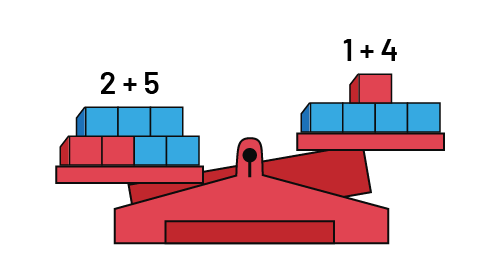C2.2 Determine what needs to be added to or subtracted from addition and subtraction expressions to make them equivalent.
Activity 1: Creating Equality Using a Pan Balance
The pan balance is a model that can be used to create equality in a practical way by having two pans physically balance.
Students first see the inequality. For example:
- There are 7 cubes on one board and 5 on the other. The tray with more cubes is lower than the other.

Have students determine what needs to be added or subtracted in order for the pans to balance. They may use any of the following strategies:
- Add cubes, preferably of a different colour, one at a time, to the high tray until the two trays are in balance. At the end of this process, two cubes will be added. Then represent the situation symbolically, that is, 2 + 5 = 1 + 4 + 2.
- Remove 2 cubes one by one from the tray which contains 7 cubes to achieve balance. Then represent this situation symbolically, that is, 2 + 5 - 2 = 1 + 4.
As with the pan balance, the mathematical balance can also be used to establish equality. In this case, the quantities will be designated using numbers and not objects.
Source: translated from Guide d’enseignement efficace des mathématiques de la maternelle à la 3e année, Modélisation et algèbre, Fascicule 2, Situations d'égalité, p. 46-47.
Activity 2: Creating Equality Using Symbols
Have students compare the terms on both sides of the equal sign.
Example
Show students the number sentence 23 + 14 ≠ 14 + 21.
Ask students the following questions:
- How does the quantity on the left side of the not equal sign compare with the quantity on the right side of it?
Students might answer: The quantity is not the same on either side of the symbol. The situation has an inequality because 23 + 14 > 14 + 21.
- What could you do to restore balance?
Students may answer: The number 14 is on both sides. The number 23 on one side is two more than the number 21 on the other side or the number 21 on the right side is two less than the number 23 on the other side. So 2 can be added to the number 21 on the right side to make it equal to the number 23 on the left side, or 2 can be subtracted from the number 23 on the left side to make it equal to the number 21 on the right side.

Source: translated from Guide d’enseignement efficace des mathématiques de la maternelle à la 3e année, Modélisation et algèbre, Fascicule 2, Situations d'égalité, p. 47.
Activity 3: Super Rocker!
Summary
In this activity, students explore relationships to establish equivalent expressions.
Materials
- Appendix 1.1, 1.2, 1.3 and 1.4 (one copy per student)
- Copy of Appendix 1.1 and Appendix 1.3 (interactive whiteboard)
- scissors
- glue
Directions
Follow the steps below.
Step 1
Display for students the Equivalent Situation 1 in Appendix 1.1. Ask students to compare the masses of the acrobats that is represented in this situation.
- Distribute a copy of Appendix 1.1 and Appendix 1.2 to the students. Ask them to complete situations 1a and 1b presented in Appendix 1.1, respecting the masses of the acrobats represented in Equivalent Situation 1.
Ask students the following questions:
- How do you know that the two sides are equivalent?
- Are there other possible solutions?
During consolidation, ask students to explain their reasoning and justify their answer.
Step 2
Display Equivalent Situation 2 in Appendix 1.3. Ask students to describe how the masses of the acrobats compare in this situation.
Distribute a copy of Appendix 1.3 and, if necessary, another copy of Appendix 1.2 to the students. Ask them to complete situations 2a and 2b presented in Appendix 1.3, respecting the masses of the acrobats represented in Equivalent Situation 1 and in Equivalent Situation 2.
Ask questions such as:
- How do you know that the two sides are equivalent?
- Are there other possible solutions?
During consolidation, ask students to explain their reasoning and justify their answer.
Step 3 (Optional)
- Distribute a copy of Appendix 1.4 to students. Challenge them to complete each of the situations 3a, 3b and 3c in two different ways.
Source: translated from Guide d’enseignement efficace des mathématiques de la maternelle à la 3e année, Modélisation et algèbre, Fascicule 2, Situations d'égalité, p. 142-143 et 145-149.
